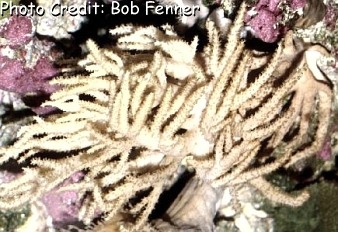
By Bob Goemans

Likely Reef Tank Suitable
Likely Fish-Only Tank Suitable
Range: Eastern Indian Ocean and Western Pacific Ocean: Widespread.
Natural Environment: This photosynthetic soft coral with long flowing lobes is often found in a variety of different environmental areas, however, most often inhabiting fairly shallow areas where somewhat strong currents exist. It is often found in large colonies and may dominate entire areas. Reproduction is usually by asexual means, with the most common form, fission, with lobes dropping off and beginning new colonies. The most common colors are various shades of cream, tan, green, or gray.
General Husbandry: Slimy to the touch and is a readily available hardy soft coral, both in the wild and in the trade.
Even though they can tolerate a wide spectrum of environmental conditions, they tend to do better in areas lit with bright light, and where moderate to strong water movement exists. Since they are photosynthetic, no direct feeding or special care is required; yet, they seem to do better in environments that are somewhat nutrient rich.
Placement in the aquarium can be wherever conditions favor it, but keep in mind it can grow quite large and quickly, therefore may shade-out nearby specimens sooner than anticipated. Provide enough space between them and their neighbors! These are especially good corals for those new to the hobby, as they are as hardy as mushroom corals!
Taxonomy:
Kingdom: Animalia
Phylum: Cnidaria
Class: Anthozoa
Subclass: Octocorallia
Order: Anlcyonacea
Suborder: Alcyoniina
Family: Alcyoniidae
Genus: Sinularia
FYI: Nevertheless, and with that said, this exact species is quite toxic to other reef species, with strong terpenes called flexibilide and dihydroflexibilide (also called sinularin and dihydrosinularin) being acutely detrimental to some species of Acropora, Catalaphyllia, Euphyllia, Plerogra and Porites (Scott Michael, 2001). In fact, this species has had many recorded incidents noting that it has appeared to inhibit or stunt growth of various stony corals.
Therefore, and since it's a hardy and readily available soft coral, besides usually being quite inexpensive and nice looking, highly recommend activated carbon be utilized at all times and be properly maintained, as any terpenes 'possibly' produced by this species or other Sinularia species can easily and safely be removed. As for those wanting to propagate this species by fragmentation, I recommend doing it outside the confines of the aquarium and allowing the 'frags' and mother colony to heal in a quarantine system before any portions are returned to the show aquarium.
This species is also a good shipper and healthy specimens are frequently available in the trade. And besides being quite hardy, it's also disease resistant, therefore an excellent choice for the beginner reef aquarist if the above activated carbon thoughts are heeded.
Experience Level: Beginner
Diet: Photosynthetic/Absorption of nutrients
Temperament: Aggressive
Aquarium Environment: Reef or fish-only aquarium
Coral Safe:With caution
Fish Safe: Yes
Invertebrate Safe: Yes
Acclimation Time: 30 minutes+
Aquarium Hardiness: Hardy
Calcium (Ca): 380 - 430 mg/l
Alkalinity: 2.5 - 3.0 meq/l
Phosphate (PO4): <0.05 mg/l
Magnesium (Mg): approx. 1350 mg/l (relate to specific gravity)
Strontium (Sr) 8 - 10 mg/l
Temperature Range: 68 - 83°F (20 - 28°C)
Minimum Tank Size: 100 gallons
Lighting: PAR 400 - 450+
Water Movement: WM 2 - 3
Specific Gravity: 1.023 - 1.025
pH: 8.0 - 8.4
Iodine/Trace Elements Monitor/as necessary to maintain quality seawater.
